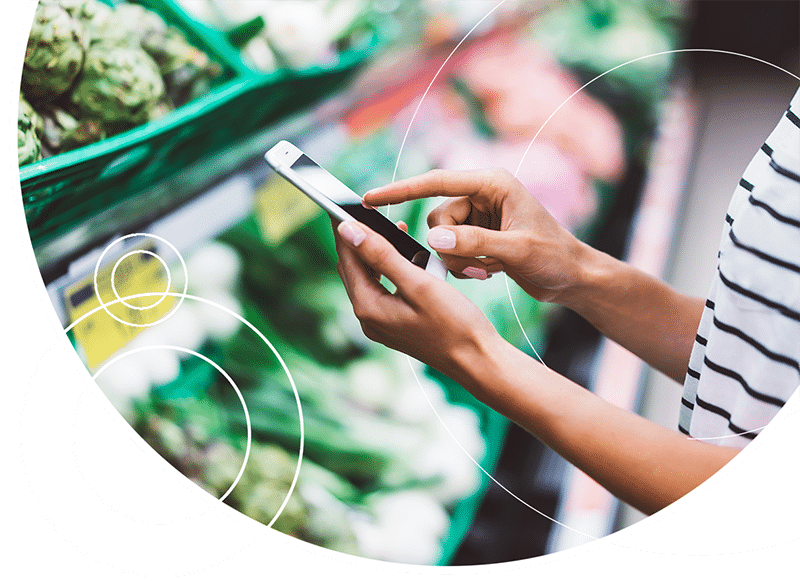There is no doubt that our global society is now firmly at a crossroads: split between the old and the new as technology permeates our daily lives more than ever before. However, with all of the technology that we have that seemingly accomplishes everything, retail is still so far behind the curve that many brands are in danger of being left behind for good.
Here’s an example. It occurred to me a few weeks ago as I perused my local grocery store that we as humans have long-running habits that connect us to our past. For instance, I shop for groceries the same way my parents shopped and, most likely, just like my grandparents did. I show up, grab a cart, and wander semi-aimlessly from aisle to aisle picking up things that I may, or may not, eventually eat. To worsen the experience, try shopping for food right after you’ve eaten—a good way to save on your grocery bill. Or worse yet, go grocery shopping before you eat—and spend $1,000 on junk food.
All jokes aside, my point is this: In many cases, we all shop without purpose, it’s a way to spend time without direction. The same can be said for the modern shopping mall. Has anything really changed in the past 50 years? Like my parents, I park, I wander around until something catches my eye and then I may or may not go into that store. Furthermore, I tend to frequent stores that have a history of carrying the things that I have liked in the past. I would assume that’s not so dissimilar to others.
So, where is the technology in all of this, you ask? This is the crossroads that I mentioned at the beginning. We seem to as a society have bifurcated our retail experiences into two distinct categories: online and brick-and-mortar—and rarely should they meet.
On the one hand, we have the highly technical, forward-thinking brands that are embracing the new technology. We order our coffee through apps and pick it up in-store. We order furniture online, we browse Amazon for hours on end (don’t judge me), and we pick and choose our retail apps in a manner that suits us. All of these instances are feeding us ideas about what other brands could be doing, but aren’t.
On the other hand, we go to malls and box stores, etc., perhaps hoping for a better and more personalized experience like the aforementioned technological ones—and never really finding one. However, that is all changing quickly.
We all see the stats that tell us how the likes of Amazon, Wayfair, eBay, and more, are all killing retail. But those online entities, along with other apps, are driving something much more: the scary new world of digital transformation.
Now, anyone that knows me will tell you I have never been one for buzzwords. And, if asked two or three years ago, I would not have used a term like digital transformation. However, it’s no longer a buzzword. It’s very real—a mantra and mindset that is literally driving all businesses to think differently about their brands and their customer experience in a way like never before.
You see, the crossroads of old and new have empowered the consumer to drive the demand for innovation. An effect that has begun to place a formidable amount pressure on brands that will inevitably determine their very existence. As we adopt more and more technology in our retail experiences, paired with the likes of social media, social interaction, and targeted marketing at every turn, our collective mindset is that of “live up to the company next to you or fail.” The power that consumers have by simply comparing every brand to another, is shifting business in directions that many can’t begin to handle.
For instance, take Starbucks. For those who like their coffee, its app is used to extend their brand experience. Now, if you can order a coffee online why can’t you order your new car with all of the features you want, right? Now, that is clearly two different conversations with an order of magnitude in difference when it comes to back-end technology. But because one has created a personalized and easy experience, human nature dictates that society will demand the same from all other brands as it is the perceived norm, or at least a possibility.
So what do retailers do? If something as easy as a coffee app is changing perceptions and demands, and many retailers are now forced to follow suit, the question becomes: At what point do the scales tip and leave those brands that haven’t embraced the new world of modern customer engagement far behind in an abandoned mall somewhere? The answer is now.
The mobile age has created the age of data that, in turn, has created the age of personalization. This combination is as addictive as any drug, and society is clearly craving and demanding more personalization as every day goes by.
In the end, digital transformation is the flip side of that coin—the path that brands need to follow to meet the expectations and demands of the consumer. The path to modern customer engagement isn’t hard to enact. The hardest part is making the choice to overcome old habits and embrace the new world order to give your customers that truly unique experience. So, in the end, ask yourself this question: What decade is my retail brand living in? If it’s anything but the present, you may have more challenges ahead than you care to realize.

Allan Zander
CEO
Allan Zander is the Chief Executive Officer at omNovos and a regular keynote speaker on the subject of Digital Transformation. Allan loves the entire process around the “art of the possible” - whiteboard sessions where he gets to turn problems into ideas, ideas into solutions, and solutions into businesses. Connect with him on LinkedIn and Twitter to start a discussion or even discover a new dinner recipe.

